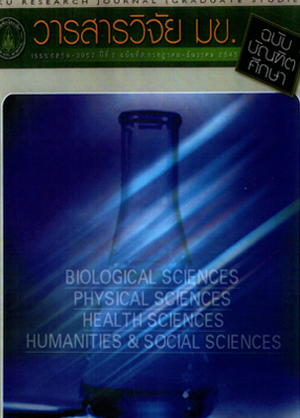Assessment of Cleaner Technology Options in Fishing Net Dyeing Process: Optimum pH and Temperature (การประเมินข้อเสนอเทคโนโลยีสะอาดในกระบวนการฟอกย้อมอวน: พีเอช และอุณหภูมิที่เหมาะสม)
Keywords:
cleaner technology, fishing net, dyeingAbstract
The objective of this research was to study feasibility in terms of techniques, economy and environment of cleaner technology options in dyeing process to save energy consumption, water resource and chemicals. The study was mainly on shed sticking of fishing net resulting from pH and temperature of dyeing liquid. In the experiment, dyeing process as standard of factory was replicated by using two sources of water; recycled water and underground water treated. From studying optimum pH and temperature of dyeing liquid, it showed that pH 5.5 and 95 0C were optimum for dyeing with both recycled and underground water. When pH of dyeing liquid was in optimum condition, it resulted in reducing time consuming and liquid use. At 95 0C, time declined from 20 minutes to 10 minutes per dye, and liquid ratio (gram/milliliter) declined from 1:20 to 1:10 (with recycled water and from 1:20 to 1:15 with underground water, respectively. In using of underground water in dyeing process, the liquid ratio per amount of dyeing liquid was supposed to be lower than by recycled water because it led to produce higher acid. Use of acid in dyeing with underground water was 8.667-liter/ton raw-fishing net, and 6.333-liter/ton raw-fishing net treated with recycled water, respectively. 352.44 bath/ton raw-fishing net and 263.03 bath/ton raw-fishing net reduced cost of dyeing in recycled water, respectively. Particularly, dyeing in optimum condition could cut down expenses and condition of wastewater after dyeing was the same as current condition.
การวิจัยครั้งนี้เพื่อศึกษาความเป็นไปได้ทางด้านเทคนิค ทางด้านเศรษฐศาสตร์ และทางด้านสิ่งแวดล้อม ของข้อเสนอเทคโนโลยีสะอาดในกระบวนการฟอกย้อมอวน เพื่อลดการใช้ พลังงานทรัพยากรน้ำและสารเคมี โดยทำการศึกษาถึงผลของการติดสีของอวน อันเนื่องมาจาก ค่าพีเอชและอุณหภูมิของน้ำย้อม ในการทดลองได้จำลองวิธีการฟอกย้อมอวนตามวิธีการ มาตรฐานการปฏิบัติงานของโรงงานกรณีศึกษา โดยใช้น้ำในการทดลอง 2 ชนิดที่โรงงาน กรณีศึกษาใช้ในกระบวนการผลิตปัจจุบัน ได้แก่น้ำรีไซเคิลและน้ำบาดาลที่ผ่านกระบวนการ ปรับปรุงคุณภาพ การศึกษาพีเอชและอุณหภูมิย้อมที่เมหาะสมในการฟอกย้อมพบว่า พีเอช 5.5 อุณหภูมิ 95 องศาเซลเซียส เหมาะสมสำหรับการฟอกย้อมทั้งการฟอกย้อมด้วยน้ำรีไซเคิลและน้ำบาดาล เมื่อพีเอชน้ำย้อมอยู่ในสภาวะที่เหมาะสมส่งผลให้สามารถลดเวลาและการใช้น้ำลงได้ คือ ลดเวลาในการฟอกย้อมที่อุณหภูมิ 95 องศาเซลเซียส จาก 20 นาทีเป็น 10 นาที ต่อการย้อม 1 ครั้ง และลดอัตราส่วนน้ำหนักอวน(กรัม) ต่อปริมาตรน้ำย้อม(มิลลิลิตร) โดยใช้น้ำ รีไซเคิลในการฟอกย้อมจากเดิม 1:20 เป็น 1:10 สำหรับการฟอกย้อมด้วยน้ำบาดาลจะลดการ ใช้น้ำจากเดิมอัตราส่วนน้ำหนักอวนต่อปริมาตรน้ำย้อม 1:20 เป็น 1:15 การใช้น้ำบาดาลในการฟอกย้อมต้องใช้อัตราส่วนน้ำหนักอวนต่อปริมาตรน้ำย้อมต่ำ กว่าการฟอกย้อมด้วยน้ำรีไซเคิลส่งผลให้ปริมาณกรดที่ใช้สูงกว่า คือ การฟอกย้อมด้วย น้ำบาดาลต้องใช้กรดปริมาตร 8.667 ลิตร/ตันอวนดิบ สำหรับการฟอกย้อมด้วยน้ำรีไซเคิล จะใช้กรดปริมาตร 6.333 ลิตร/ตันอวน ค่าใช้จ่ายโดยรวมที่สามารถประหยัดได้เมื่อการ ฟอกย้อมอยู่ในสภาวะที่เหมาะสม สำหรับการฟอกย้อมด้วยน้ำรีไซเคิลเป็นเงิน 352.44 บาท/ ตันอวนดิบ สำหรับการฟอกย้อมด้วยน้ำบาดาลเป็นเงิน 263.03 บาท/ตันอวนดิบ การฟอกย้อม ในสภาวะที่เหมาะสมนอกจากสามารถลดค่าใช้จ่ายลงดังกล่าวแล้ว คุณสมบัติน้ำทิ้งหลังการ ฟอกย้อมไม่แตกต่างจากการฟอกย้อมที่สภาวะปัจจุบันมากนัก



